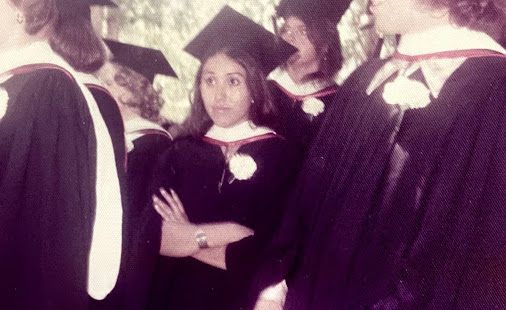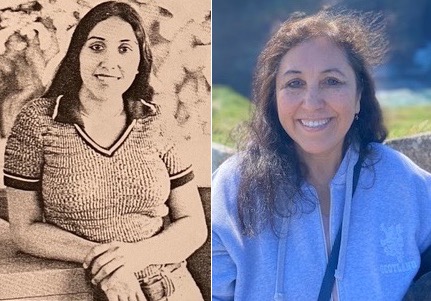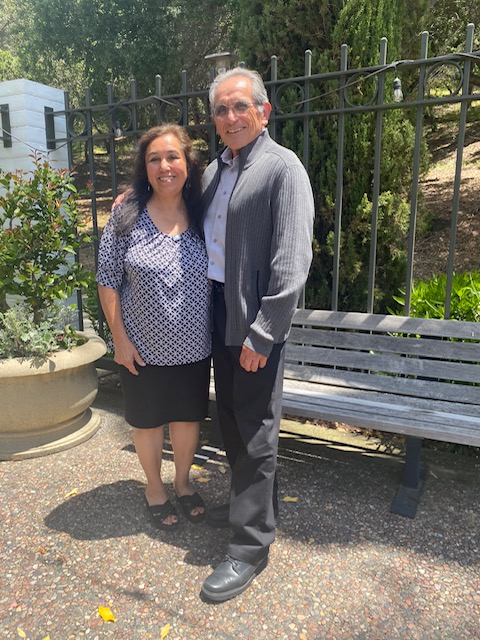
Graduation Day: Elizabeth Sandoval '76. Of the student protests that eventually led to the creation of the High Potential Program, she says, “Those students were basically saying, ‘Hey, we're here. You've brought us here. We believe in ourselves. We think there should be more.'” / Photos courtesy of Elizabeth Sandoval
Fifty Years of High Potential: Elizabeth Sandoval ’76 Was There From the Very Beginning
A first-generation college student and one of the first women to attend Saint Mary’s, Sandoval would go on to serve as a California state attorney for decades. She was also part of the team that helped High Potential get off the ground.
During the 2023–24 academic year, Saint Mary's is celebrating half a century of high potential. Since 1973, the College's High Potential Program has offered low-income and first-generation college students the support they need to thrive, on campus and out in the world. Above all, High Potential students consider the program a family—one that continues to expand, offering nurture and support.
To honor this milestone, the SMC NewsCenter is launching a new series, Fifty Years of High Potential. We're partnering with Professor of History Aeleah Soine and students in her Spring 2023 Public History course, who conducted oral history interviews across generations, to introduce you to HP family members, past and present. We share the stories of HP students and alums in their own words.
Meet Elizabeth Sandoval '76: a first-generation college student and one of the first Latinx women to attend Saint Mary's. Sandoval earned her JD degree from UC San Francisco Law in 1979 and served as a California state attorney for more than three decades.

In Her Own Words: From Marysville to Saint Mary's
I grew up in Marysville, up in Northern California. A rural town, lots of agriculture there. My parents were small business owners who ran a nightclub in town. Neither of them had achieved a high school education. In fact, my mother didn't get farther than second grade.
Nonetheless, they valued education, and they'd saved up enough to send me to private Catholic schools throughout childhood. But the only reason I could attend college was my grades and financial aid. And I only applied to one school: Saint Mary's. Good thing I got in!
Lost and Found
A state scholarship paid for my tuition and the College assisted with room and board. I also did work-study while I attended SMC. My first year, I helped out Brother Dennis, the head librarian at the college. A wonderful, supportive individual and mentor. We spent a lot of time in the archives, sifting through records from the good old football days and the Collegian newspaper. I remember once, he came to show me a hand-written manuscript, work done by a monk from the 1300s or 1400s. Fascinating little book. But then, a little later, he comes back and says, "Liz, I can't find the book." He'd put it down somewhere. And I'm going, "That's a priceless book!"
So we were frantically searching throughout the library. And, of course—right next to his office.
Times a Changin'
Saint Mary's was in transition when I arrived in 1972. Of course, more broadly, it was a time of tremendous change for the country, coming on the heels of the civil rights movements of the 1960s. The College had just started admitting women two years before, and I'm proud to say I was among the initial batch of women. And there was an influx of African American students, Mexican American students, and students from around the world: from Africa, from Iran, from the Philippines.
Still, even though Saint Mary's was diversifying, it didn't have a handle on how to support those students once at SMC. The previous school year—a few months before I arrived on campus—Black and Chicano students held protests and strikes. There was the Basketball Walkout, and then a number of minority students occupied the Chapel for days. Those students were basically saying, "Hey, we're here. You've brought us here. We believe in ourselves. We think there should be more." And that's what I believe ultimately led to the creation of the High Potential Program.
"The values I developed in my years at Saint Mary's, I carried them on in my career."
The Early Days of High Potential
The administrators behind the program—Tom Brown, Inez Gomez, and eventually Brother Camillus Chavez—all came out of some of the social movements of the time, which was significant. They understood what we were going through. A lot of us first-generation college students felt isolated and frustrated. We needed each other to remain focused and strong.
We needed support, too, and so High Potential was established to offer that support. I worked with Tom Brown as part of the team that helped the program get a good start. We developed the various aspects of the program: orientation for first-generation students, tutoring assistance, peer mentoring. There was the Third World Center, too, which is now the Intercultural Center. It was very important at that time, because that's where we all hung out. I helped curate the center's library. And then, when I started working with Admissions, I helped recruit Hispanic students to the College and review applicants who were good candidates for High Potential.
It was all still getting off the ground. But overall, my experience with High Potential was knowing that people and support systems were there for incoming students.

The Spark of a Career
I knew coming into college that I wanted to go into law, with a focus on civil rights and equality. Part of that came from experiences back in Marysville, from discriminatory things my own family had experienced. But that desire was solidified when I came to Saint Mary's.
During Jan Term one year, as I was working on a project about women's reproductive rights, I met a young attorney named Antonia Hernandez. She ended up becoming the head of the Mexican-American Legal Defense and Education Fund. When I met Antonia, she'd recently litigated a lawsuit involving a major Los Angeles hospital. She'd come across hundreds of cases of Mexican women who, at the time of giving birth, were pressured into getting sterilized. Ultimately, Antonia's work paved the way for major reforms in California, including laws requiring informed consent prior to any sterilization.
Meeting Antonia really inspired me on my path. As an attorney, my work has always been about helping the underrepresented. For several years, I did immigration work with Catholic Charities Immigration Projects. Later, when I worked for the state, I was a discrimination law enforcement attorney. I ended my career with California's Department of Social Services (CDSS), where I served for over 20 years. As part of my work with CDSS, I was assigned to issues related to Native American children in the foster care system.
So the values I developed in my years at Saint Mary's, I carried them on in my career.

Five Decades Later
I'm 70 now, and it's incredible to think about where the first wave of Latinx students from the early '70s ended up: authors, teachers, college professors, attorneys. In the graduating class before me, there was María Elena Durazo '75, who marched with Cesar Chavez and went on to become the leader of one of the largest unions in Los Angeles. She's currently a California state senator.
I don't want to say that my time at SMC was all peachy. There was a lot of intensity, honestly, as the College strived to improve things for first-generation students. But the college has progressed so much. I've been to some events on campus in recent years. At one, I watched Ballet Folklórico perform, and I was so impressed and in awe with the number of Latinx students onstage dancing and in the audience. You have to remember: When I came to Saint Mary's, I was one of maybe five women of Mexican descent in total. Nothing like what I see now.
This interview has been edited and condensed for clarity.
LEARN MORE about the High Potential Program and its legacy of student-centered support. CONSIDER GIVING to support its mission. And if you’re a High Potential graduate, please add your info to our ALUMNI DIRECTORY.
READ MORE: Making Family History: Rebecca Carranza '26 Sees Humanity in the Work of the Law
See all the latest news from Saint Mary’s at the SMC NewsCenter.
Olivia Watkin '24 is an Anthropology major with an emphasis in Archaeology. She conducted this interview as part of her Spring 2023 Public History Course.
Hayden Royster, who edited this piece, is Staff Writer in the Office of Marketing and Communications. Write him.